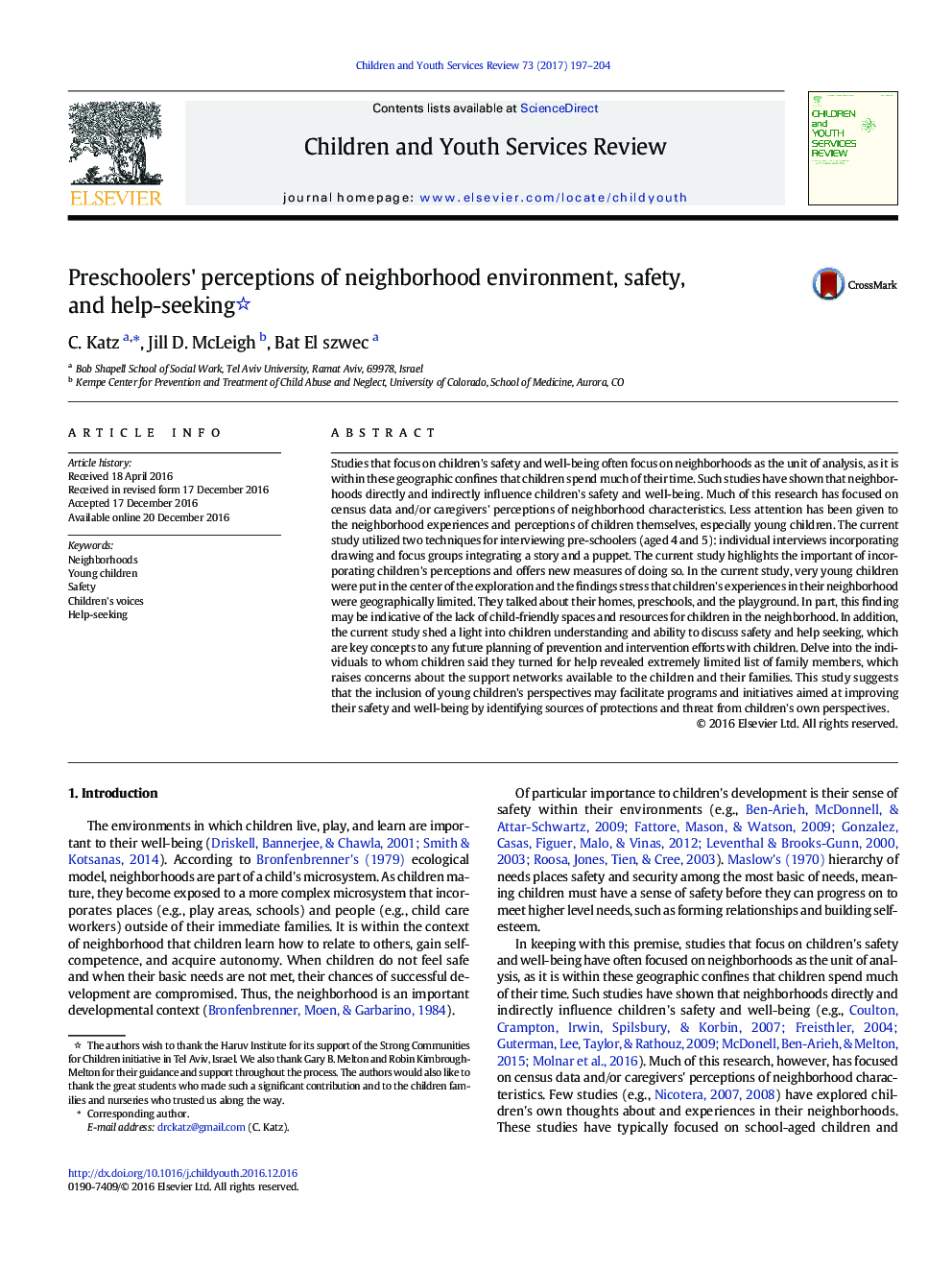| کد مقاله | کد نشریه | سال انتشار | مقاله انگلیسی | نسخه تمام متن |
|---|---|---|---|---|
| 4936577 | 1434436 | 2017 | 8 صفحه PDF | دانلود رایگان |
عنوان انگلیسی مقاله ISI
Preschoolers' perceptions of neighborhood environment, safety, and help-seeking
ترجمه فارسی عنوان
ادراک پیش دبستانی ها از محله محله، ایمنی و کمک به دنبال
دانلود مقاله + سفارش ترجمه
دانلود مقاله ISI انگلیسی
رایگان برای ایرانیان
کلمات کلیدی
محله ها، بچه های جوان، ایمنی، صدای کودکان، جستجوی راهنما،
ترجمه چکیده
مطالعاتی که بر سلامت و رفاه کودکان تمرکز می کنند، اغلب در محله ها به عنوان واحد تحلیلی تمرکز می کنند، زیرا در این محدوده جغرافیایی، کودکان بیشتر وقت خود را صرف می کنند. چنین مطالعات نشان داده اند که محله ها به طور مستقیم و غیر مستقیم بر ایمنی و رفاه کودکان تأثیر می گذارد. بسیاری از این تحقیق بر روی داده های سرشماری و / یا درک پرستاران از ویژگی های محله متمرکز شده است. توجه کمتر به تجارب محله و ادراکات فرزندان خود، به ویژه کودکان کم است. مطالعه حاضر با استفاده از دو تکنیک برای مصاحبه با دانش آموزان پیش دبستانی (4 و 5 ساله) انجام شد: مصاحبه های فردی شامل طراحی و تمرکز گروه هایی که داستان و عروسک را ادغام می کردند. در این مطالعه، مهم است که درک ادراکات کودکان به کار گرفته شود و اقدامات جدیدی را برای انجام این کار ارائه می دهد. در مطالعه حاضر، کودکان بسیار جوان در مرکز اکتشاف قرار گرفتند و یافته ها بر این باورند که تجارب کودکان در محله خود به لحاظ جغرافیایی محدود است. آنها درباره خانه ها، پیش دبستان ها و زمین بازی صحبت کردند. به طور جزئی، این یافته ممکن است نشان دهنده فقدان فضاهای دوستانه کودک و منابع برای کودکان در محله باشد. علاوه بر این، مطالعه فعلی نور را به درک کودکان و توانایی بحث در مورد ایمنی و کمک به دنبال کردن، که مفاهیم کلیدی برای برنامه ریزی آینده برنامه های پیشگیری و مداخله با کودکان است، بی فایده می سازد. افرادی را که به آنها بچه ها گفته اند برای کمک به آنها مراجعه کرده اند، نشان می دهد لیست بسیار محدودی از اعضای خانواده را نشان می دهد که موجب نگرانی در مورد شبکه های حمایت از کودکان و خانواده های آنها می شود. این مطالعه نشان می دهد که گنجاندن دیدگاه های کودکان جوان ممکن است برنامه ها و ابتکارات را با هدف بهبود ایمنی و رفاه آنها با شناسایی منابع حمایت و تهدید از دیدگاه های کودکان تسهیل کند.
موضوعات مرتبط
علوم پزشکی و سلامت
پزشکی و دندانپزشکی
پریناتولوژی (پزشکی مادر و جنین)، طب اطفال و بهداشت کودک
چکیده انگلیسی
Studies that focus on children's safety and well-being often focus on neighborhoods as the unit of analysis, as it is within these geographic confines that children spend much of their time. Such studies have shown that neighborhoods directly and indirectly influence children's safety and well-being. Much of this research has focused on census data and/or caregivers' perceptions of neighborhood characteristics. Less attention has been given to the neighborhood experiences and perceptions of children themselves, especially young children. The current study utilized two techniques for interviewing pre-schoolers (aged 4 and 5): individual interviews incorporating drawing and focus groups integrating a story and a puppet. The current study highlights the important of incorporating children's perceptions and offers new measures of doing so. In the current study, very young children were put in the center of the exploration and the findings stress that children's experiences in their neighborhood were geographically limited. They talked about their homes, preschools, and the playground. In part, this finding may be indicative of the lack of child-friendly spaces and resources for children in the neighborhood. In addition, the current study shed a light into children understanding and ability to discuss safety and help seeking, which are key concepts to any future planning of prevention and intervention efforts with children. Delve into the individuals to whom children said they turned for help revealed extremely limited list of family members, which raises concerns about the support networks available to the children and their families. This study suggests that the inclusion of young children's perspectives may facilitate programs and initiatives aimed at improving their safety and well-being by identifying sources of protections and threat from children's own perspectives.
ناشر
Database: Elsevier - ScienceDirect (ساینس دایرکت)
Journal: Children and Youth Services Review - Volume 73, February 2017, Pages 197-204
Journal: Children and Youth Services Review - Volume 73, February 2017, Pages 197-204
نویسندگان
C. Katz, Jill D. McLeigh, Bat El szwec,
